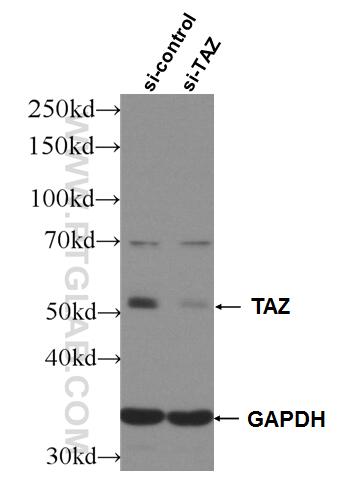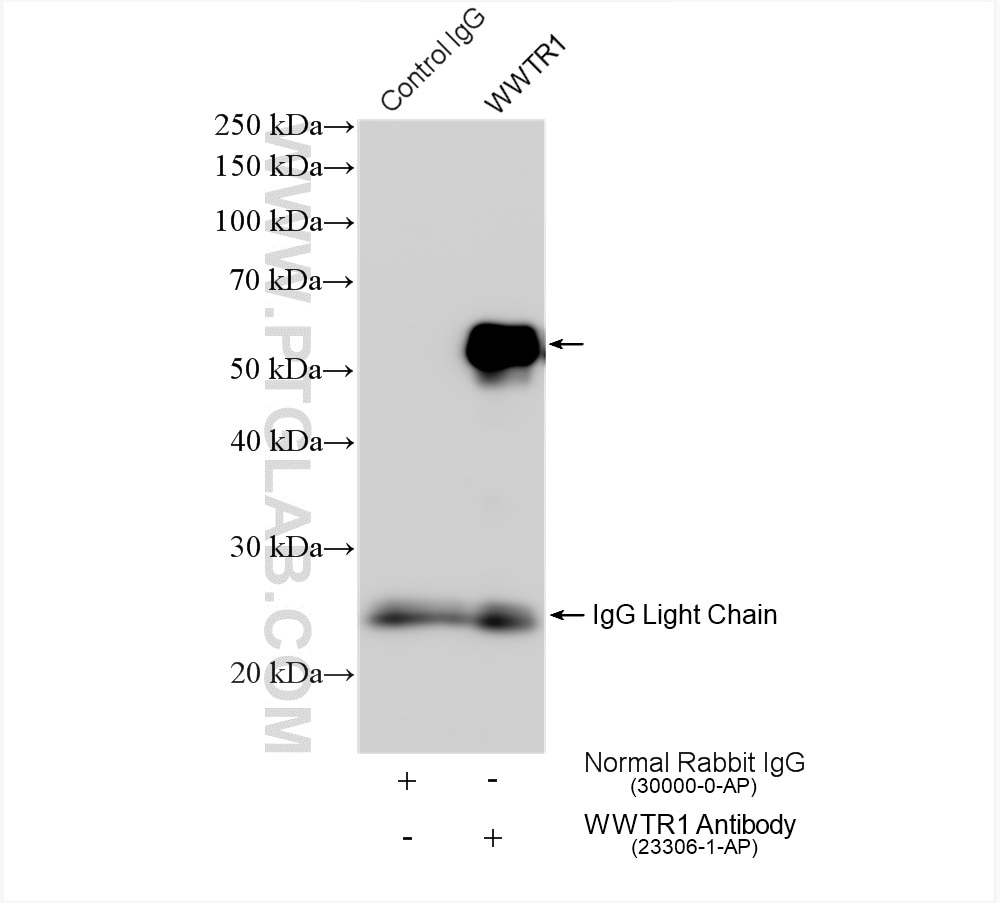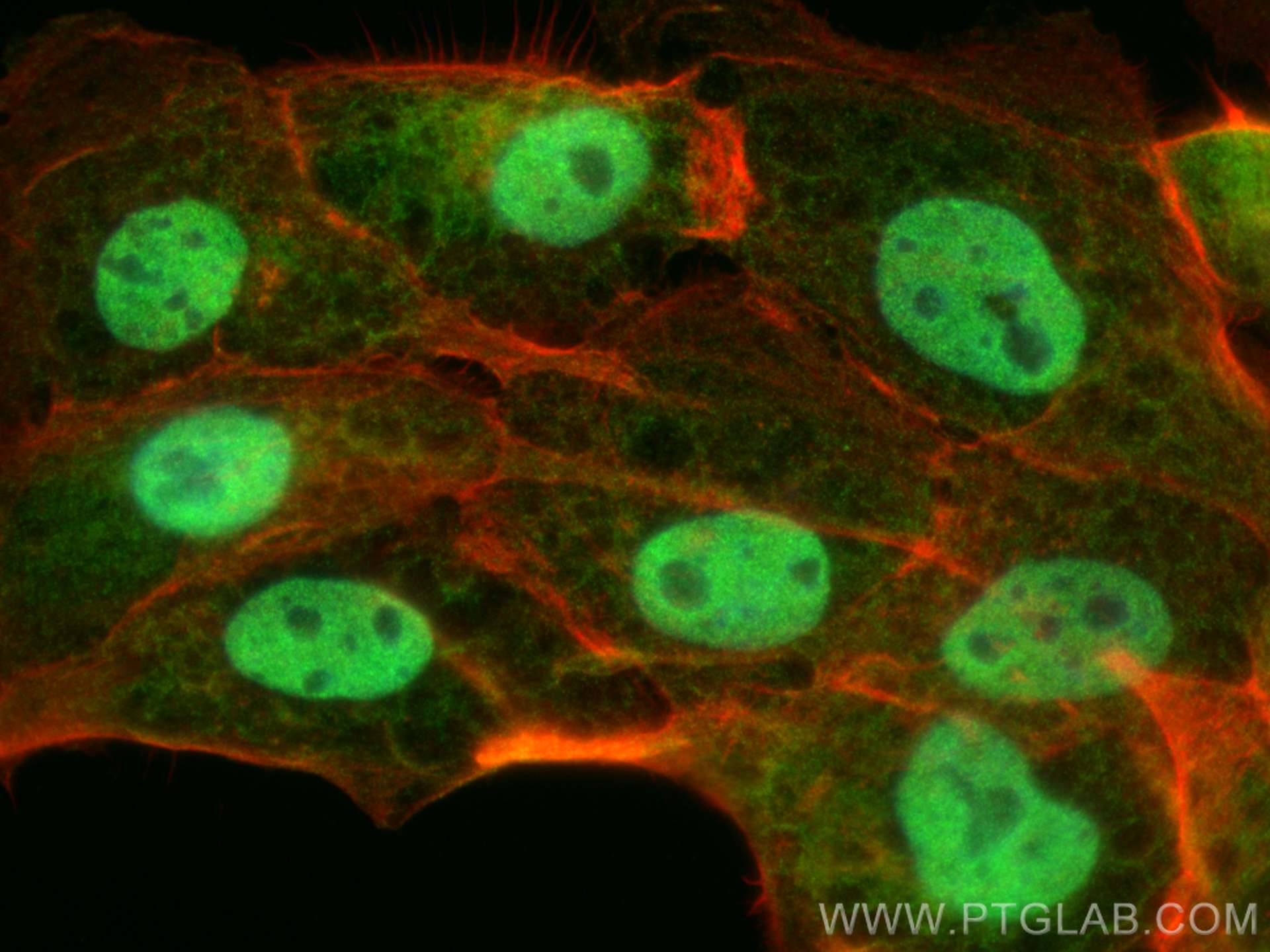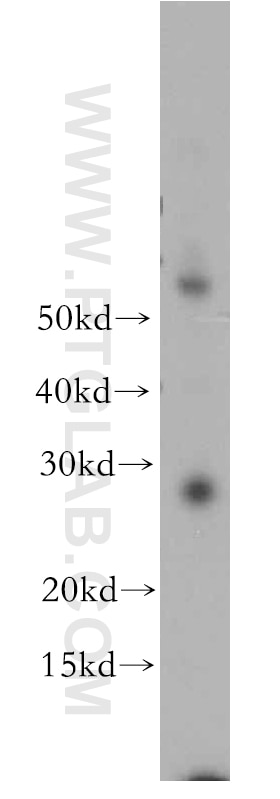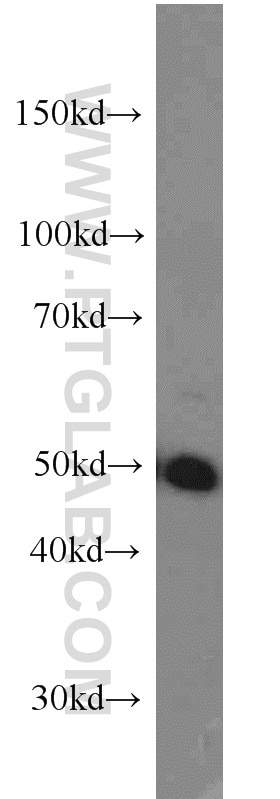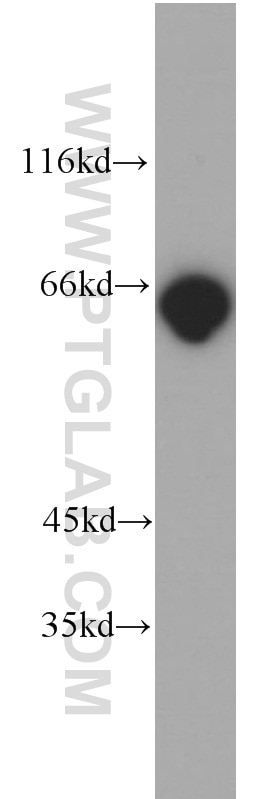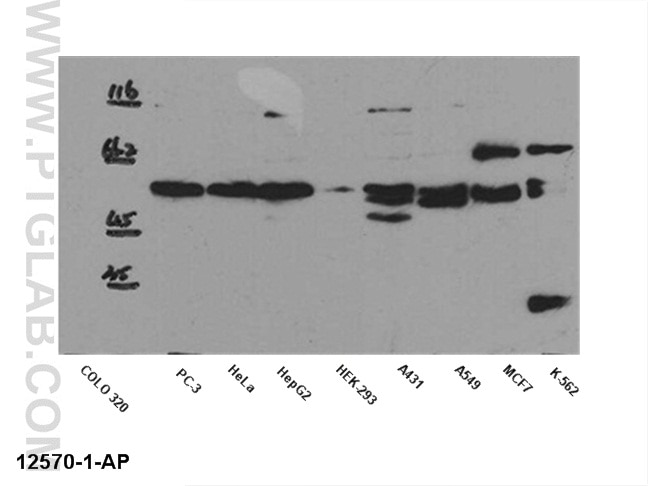- Phare
- Validé par KD/KO
Anticorps Polyclonal de lapin anti-WWTR1
WWTR1 Polyclonal Antibody for WB, IF/ICC, IF-P, IP, ELISA
Hôte / Isotype
Lapin / IgG
Réactivité testée
Humain, rat et plus (1)
Applications
WB, IHC, IF/ICC, IF-P, IP, CoIP, ChIP, ELISA
Conjugaison
Non conjugué
N° de cat : 23306-1-AP
Synonymes
Galerie de données de validation
Applications testées
| Résultats positifs en WB | cellules HeLa, cellules LN229, cellules MDA-MB-453s |
| Résultats positifs en IP | cellules MDA-MB-453s, |
| Résultats positifs en IF-P | tissu rénal de rat, |
| Résultats positifs en IF/ICC | cellules U-251, |
Dilution recommandée
| Application | Dilution |
|---|---|
| Western Blot (WB) | WB : 1:1000-1:8000 |
| Immunoprécipitation (IP) | IP : 0.5-4.0 ug for 1.0-3.0 mg of total protein lysate |
| Immunofluorescence (IF)-P | IF-P : 1:50-1:500 |
| Immunofluorescence (IF)/ICC | IF/ICC : 1:50-1:500 |
| It is recommended that this reagent should be titrated in each testing system to obtain optimal results. | |
| Sample-dependent, check data in validation data gallery | |
Applications publiées
| KD/KO | See 7 publications below |
| WB | See 41 publications below |
| IHC | See 11 publications below |
| IF | See 6 publications below |
| IP | See 3 publications below |
| CoIP | See 1 publications below |
| ChIP | See 1 publications below |
Informations sur le produit
23306-1-AP cible WWTR1 dans les applications de WB, IHC, IF/ICC, IF-P, IP, CoIP, ChIP, ELISA et montre une réactivité avec des échantillons Humain, rat
| Réactivité | Humain, rat |
| Réactivité citée | rat, Humain, souris |
| Hôte / Isotype | Lapin / IgG |
| Clonalité | Polyclonal |
| Type | Anticorps |
| Immunogène | WWTR1 Protéine recombinante Ag19659 |
| Nom complet | WW domain containing transcription regulator 1 |
| Masse moléculaire calculée | 44 kDa |
| Poids moléculaire observé | 50 kDa |
| Numéro d’acquisition GenBank | BC014052 |
| Symbole du gène | WWTR1 |
| Identification du gène (NCBI) | 25937 |
| Conjugaison | Non conjugué |
| Forme | Liquide |
| Méthode de purification | Purification par affinité contre l'antigène |
| Tampon de stockage | PBS avec azoture de sodium à 0,02 % et glycérol à 50 % pH 7,3 |
| Conditions de stockage | Stocker à -20°C. Stable pendant un an après l'expédition. L'aliquotage n'est pas nécessaire pour le stockage à -20oC Les 20ul contiennent 0,1% de BSA. |
Informations générales
TAZ, also referred as WWTR1, is a transcriptional co-activator with a PDZ-binding motif that is regulated by its interaction with 14-3-3 protein. TAZ is expressed in many primary tumors, such as breast cancer, thyroid carcinoma, colorectal cancer, and glioma. TAZ has been reported to be one of the nuclear effectors of Hippo-related pathways that regulate organ size control, cancer stem cell (CSC) properties, and epithelial-mesenchymal transition (EMT). TAZ has been defined for its role in the nucleus, where it functions directly as a transcriptional regulator by interacting with several nuclear factors as Runx2/Cbfa1, NHERF-2, TEF-1, TBX5, PAX3, PAX8 and TTF-1.
Protocole
| Product Specific Protocols | |
|---|---|
| WB protocol for WWTR1 antibody 23306-1-AP | Download protocol |
| IF protocol for WWTR1 antibody 23306-1-AP | Download protocol |
| IP protocol for WWTR1 antibody 23306-1-AP | Download protocol |
| Standard Protocols | |
|---|---|
| Click here to view our Standard Protocols |
Publications
| Species | Application | Title |
|---|---|---|
Cancer Cell Programming of Schwann Cells by Lats1/2-TAZ/YAP Signaling Drives Malignant Peripheral Nerve Sheath Tumorigenesis. | ||
Nat Neurosci YAP and TAZ control peripheral myelination and the expression of laminin receptors in Schwann cells.
| ||
Sci Adv YAP drives fate conversion and chemoresistance of small cell lung cancer.
| ||
Bone Res TAZ inhibits osteoclastogenesis by attenuating TAK1/NF-κB signaling.
| ||
Clin Transl Med NSUN2 promotes colorectal cancer progression by enhancing SKIL mRNA stabilization |
Avis
The reviews below have been submitted by verified Proteintech customers who received an incentive forproviding their feedback.
FH Yohanes (Verified Customer) (04-24-2023) |
|
FH Joshua (Verified Customer) (02-28-2020) | MDCKs fixed in 4% paraformaldehyde. Bright Mix of nuclear and cytosolic staining
 |

